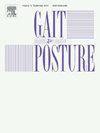需要步态监督的腰椎融合术患者的稳定性边缘特征
IF 2.2
3区 医学
Q3 NEUROSCIENCES
引用次数: 0
摘要
背景:尽管步态监测是康复治疗的一个关键挑战,但目前还没有研究人员对需要监测的患者的步态稳定性进行描述。最近,稳定裕度(MoS)在评估特定时刻的稳定性方面得到了突出的应用。研究问题:是否有可能使用MoS来描述极端外侧体间融合(XLIF)后步态监测(GS)患者的特征?不稳定性的方向是否取决于损伤的形式?方法本横断面研究纳入66例行XLIF的患者,并在术后1个月进行评估。MoS计算为外推质心(XCoM)到XLIF插入侧足的支撑底(BoS)边界的距离。当XCoM分别移动到bo的后侧和内侧边界时,后侧AP-MoS显示后侧偏移,ML-MoS显示内侧偏移。采用多元逻辑回归分析来证实这些偏差对步态监督的影响。采用决策树分析法,根据不稳定方向识别需要解决的损伤。结果步态独立组46例,步态监测组20例。后偏的优势比为106.896(置信区间(CI): 95 %,12.572-1915.886),内侧偏的优势比为173.953 (CI: 95 %,14.806-1287.583)。膝关节伸展和髋关节外展强度可显著区分后侧和内侧偏差。MoS成功地表征了GS患者的稳定性,为解决步态监督问题提供了有价值的见解。我们的发现强调了考虑不稳定性方向的治疗干预的必要性。本文章由计算机程序翻译,如有差异,请以英文原文为准。
Characterization by margin of stability in lumbar fusion patients requiring gait supervision
Background
Although gait supervision poses a key challenge in rehabilitation, no prior researcher has characterized the gait stability of patients requiring supervision. Recently, margin of stability (MoS) has gained prominence for assessing stability at specific moments.
Research question
Is it possible to characterize gait-under-supervision (GS) patients after extreme lateral interbody fusion (XLIF) using the MoS? Could the direction of instability depend on the form of impairments?
Methods
This cross-sectional study included 66 patients who underwent XLIF and were assessed one month postoperatively. The MoS was calculated as the distance from the extrapolated center of mass (XCoM) to the base of support (BoS) boundary of the XLIF insertion-side foot. The posterior AP-MoS indicated a posterior deviation, and the ML-MoS indicated a medial deviation, when the XCoM moved beyond the posterior and medial boundaries of the BoS, respectively. Multiple logistic regression analysis was performed to confirm the effects of such deviations on gait supervision. Decision tree analysis was adopted to identify impairments requiring resolution based on the direction of instability.
Results
Forty-six patients were in the gait-independent group and 20 in the gait-supervision group. The odds ratio for posterior deviation was 106.896 (confidence interval (CI): 95 %, 12.572–1915.886) and 173.953 (CI: 95 %, 14.806–1287.583) for medial deviation. Knee extension and hip abduction strength significantly differentiated posterior and medial deviations.
Significance
The MoS successfully characterized GS patients' stability, offering valuable insights for resolving gait supervision. Our findings highlight the need for therapeutic interventions that consider the direction of instability.
求助全文
通过发布文献求助,成功后即可免费获取论文全文。
去求助
来源期刊

Gait & posture
医学-神经科学
CiteScore
4.70
自引率
12.50%
发文量
616
审稿时长
6 months
期刊介绍:
Gait & Posture is a vehicle for the publication of up-to-date basic and clinical research on all aspects of locomotion and balance.
The topics covered include: Techniques for the measurement of gait and posture, and the standardization of results presentation; Studies of normal and pathological gait; Treatment of gait and postural abnormalities; Biomechanical and theoretical approaches to gait and posture; Mathematical models of joint and muscle mechanics; Neurological and musculoskeletal function in gait and posture; The evolution of upright posture and bipedal locomotion; Adaptations of carrying loads, walking on uneven surfaces, climbing stairs etc; spinal biomechanics only if they are directly related to gait and/or posture and are of general interest to our readers; The effect of aging and development on gait and posture; Psychological and cultural aspects of gait; Patient education.
 求助内容:
求助内容: 应助结果提醒方式:
应助结果提醒方式:


